London Design Biennale 2023
Sommerset House, London, has been the home of London Design Biennale 2023 since the 1st of June. Now in it’s 4th year, the Biennale displays more than 40 installations by design teams from across the world, each confronting a global challenge to inspire their audience. This year’s event has the theme ‘The Global Game: Remapping Collaborations’ devised by Artistic Director the Nieuwe Instituut, led by Aric Chen.
Taking over the entirety of Somerset House, the Biennale explores themes that range from the urban environment to traditional practices, sustainability to the humanitarian response to conflict. Understanding design as a collaborative practice at a time of both global challenges and a shifting geopolitical environment, ‘The Global Game’ encourages the Biennale’s participants to explore the importance of collaboration, in part with the help of a specially-commissioned, web-based game.
The investment of time in visiting this event was immeasurably valuable, the experience was deeply thought provoking and inspirational. As the commercial interiors sector we must experience these concepts being explored at their core, through events like these, if we are going to be in a position to successfully collaborate with product and system designers, especially when considering radical approaches to sustainability and social responsibility.
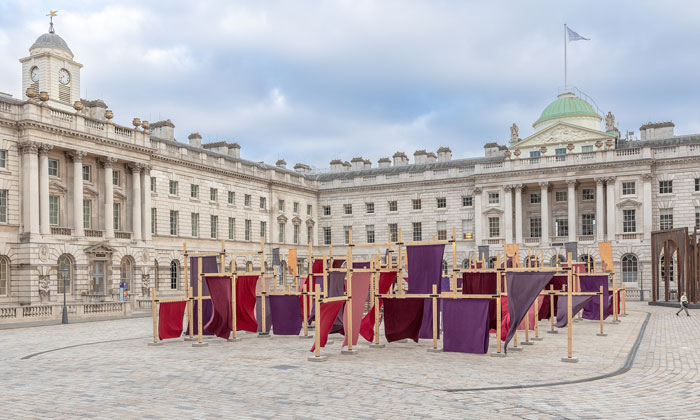
Creative Team: Matthew Joseph Casha, Trevor Borg, Luke Azzopardi, Alessia Deguara
On arrival the courtyard was brought to life with Malta’s installation Urban Fabric, a large-scale ‘village-square’ installation that merges traditional city planning with the Phoenician-Maltese tradition of fabric production and dyeing of the multiple colours of Phoenician purple. A ‘street-like’ layout is created which blew joyfully in the wind on an extremely sunny day, giving the opportunity for visitors to meet as they strolled through the installation.
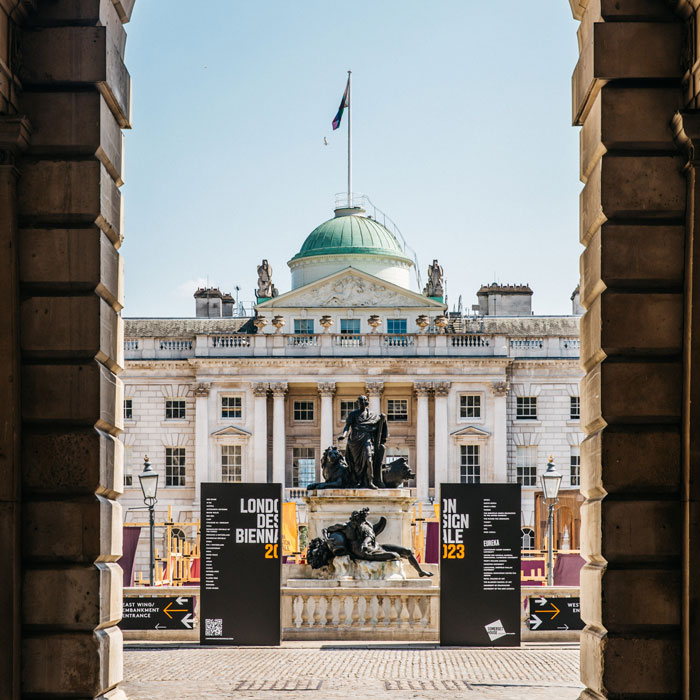
The enormity of this event was twofold: firstly the expansive floorplan it covered and the volume of participants, and secondly the weight of the concepts the work asked the viewer to bear.
New to this year’s Biennale, the EUREKA exhibition showcased design-led innovation from the UK’s leading research centres, featuring cross-disciplinary invention and creativity from academics, leaders and problem solvers. As an event venue Somerset House offers a network of rooms spread along a series of corridors and on multiple floors which, despite a map, meant that our experience lacked flow. Despite one of our stand out installations being part of the EUREKA showcase, Lab4Living and Sheffield Hallam University’s work reimagining the 100-year life, the addition of institutions alongside countries further disrupted the continuity of the event.
We spent several hours immersed in the concepts explored by the global design teams, many of which demanded considerable thought and consideration, after all, that was their intention. It was difficult to digest so many concepts to the depth we would have liked which was a shame considering the expertise being showcased, perhaps we needed to return for a second visit!
We had two clear event highlights:
Poland: Poetics of necessity
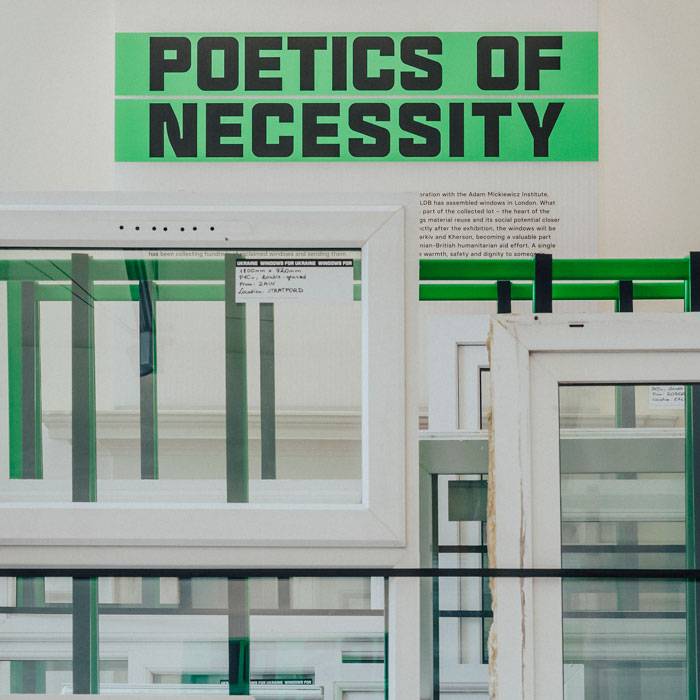
Curators: Zofia Jaworowska, Michał Sikorski, Petro Vladimirov
In times of need, urgency and uncertainty begin to enter the creative process, while architecture and design mix with social activism. Those are the days of change, adaptation and hope – new sources of creativity. The exhibition explores how unexpected objects such as reclaimed windows emerge from the world of reuse, and crisis collaboration.
In times of crisis, especially when available resources change and shrink, the world relies on new communities and new processes. Designers have to divert from aesthetics to functionality, but still remain creative in their work. This exhibition aims to reinterpret objects and tools that spontaneously emerge in grassroots humanitarian aid activities.
Here, a building element, the humble window, transforms from waste into a chance for safety. It becomes a transmitter of new relationships, a barometer of the most urgent needs. The window serves as a starting point for a discussion about new aesthetics in design in times of sudden geopolitical shifts.
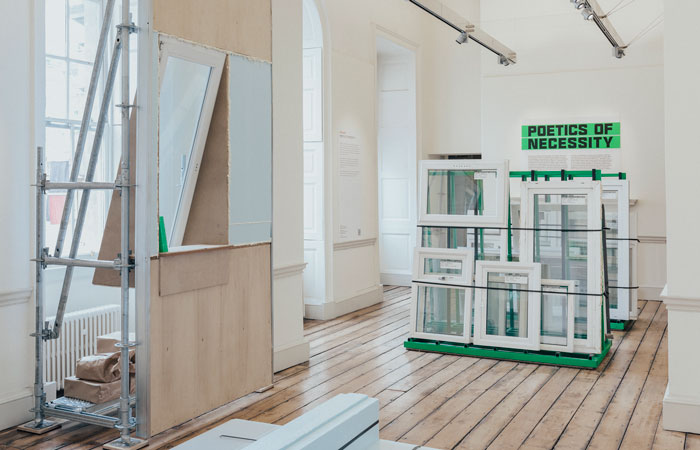
Designers: Nicolò Signori, Michał Sikorski, TŁO Michał Sikorski Architects
The installation is inspired by the WINDOW project – a call to action to collect reusable windows, given by Poles to Ukrainians stripped of dignified living conditions as a result of war.
When donors give windows, they are connected to the receiver who may be thousands of kilometres away – there is a fascinating trajectory of a window from home to home. Windows are often abandoned in Polish garages, hastily removed during renovations, yet they have become valuable treasures, not only from an environmental perspective – but for human survival.
The pavilion asks questions around the durability of the objects on display, built for times of crisis and insecurity – and what is expected of a modern designer at these moments? The window installation at the heart of the pavilion is just as shapeshifting and open as the collective images of Europe’s fate. In this world of shaken fundamentals, there is still space for empathy, new collaborations and ‘new poetics’, which attempt to grasp the complex emotional temperature and logic of our times.
Organisers: Larysa Tsybina- Curator of the Ukrainian Pavilion, Denys Sokolov – Art Director, SVOYA Studio, Dmytro Sivak – Architect, Sivak + Partners Bureau.
Designers: Viktoria Yakusha – Faina, Sergiy Hotvianskyi – Nottdesign, Kateryna Sokolova – Arkadii Vartanov, Noom
Lab4Living, Sheffield Hallam University: Re-imagining the 100-year Life
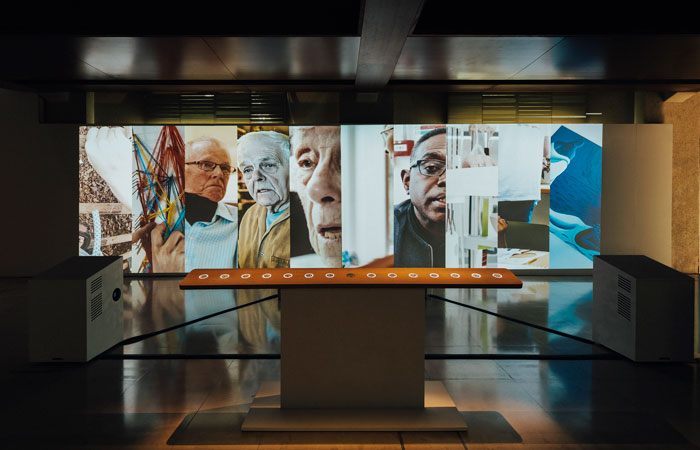
Lab4Living, Sheffield Hallam University
“One in three individuals born in the West today can expect to live to be 100.” Office for National Statistics
This is a project undertaken by researchers in Lab4Living, a ‘Living Lab’ based at Sheffield Hallam University in the UK that adopts a co-creation approach, integrating research and innovation processes in real life communities and settings. The installation will explore the role of design and creative practice in disrupting existing medical, social, and cultural discourses around ageing.
Over the last three years, film, photography, exhibitions and creative writing are some of the methods that have been used to give voice to people about their experiences of growing older. Through these methods, Lab4Living have built new insights and understanding of the multiple transitions that ageing inevitably brings and the role that design plays in helping individuals to navigate these.
‘Re-imagining the 100-year Life’ has led to bodies of work, spanning multiple enquiries and raising questions about the meaning of home, our relationship with the natural environment, understanding of care and the essence of what it is to be human.
As these interrelated investigations have emerged, there have been many voices and perspectives. Rather than inviting the audience to see each project in isolation, this installation invites the audience to find their own way through, to map their own connections within, between and across projects and to engage in their own process of discovery to re-imagine the 100-year life.
Additional works of interest include:
Denmark & Switzerland: Blue Nomad
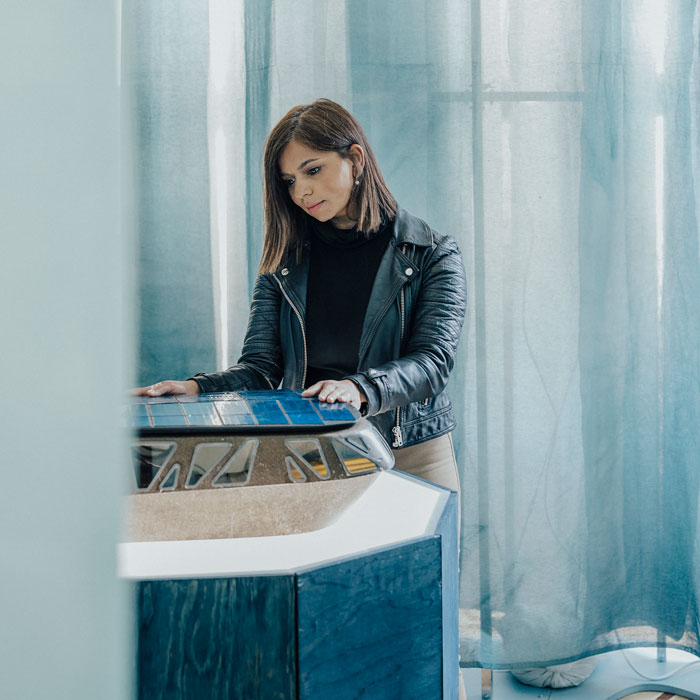
Design and Development: Students Institut auf dem Rosenberg (Students K1-12), SAGA Space Architects
‘Blue Nomad’ is a self-sufficient solar floating habitat showcasing a fossil-free future for living and travelling on the ocean. To address climate change, rising sea levels and contemporary nomadism, ‘Blue Nomad’ provides a small, comfortable, and permanent living space that relies purely on solar power.
Every hour, the surface of the Earth receives more energy from the sun than the entire population of our planet can consume in a year. With a growing population, the Denmark and Switzerland pavilion wants to explore the 70% of the Earth that is covered by water as a potential habitable space for human living.
‘Blue Nomad’ draws inspiration from the lifestyle of the first Polynesian nomadic settlements. Their typical way of exploring the world was via an outrigger – a boat projection made of organic materials with ocean stability through a side pontoon. The project proposes an idea of future travelling and living on water that relies purely on solar energy for propulsion, fresh water, food production and electricity, providing a close to fully self-sufficient home.
Ai-Da: AI Mind Home
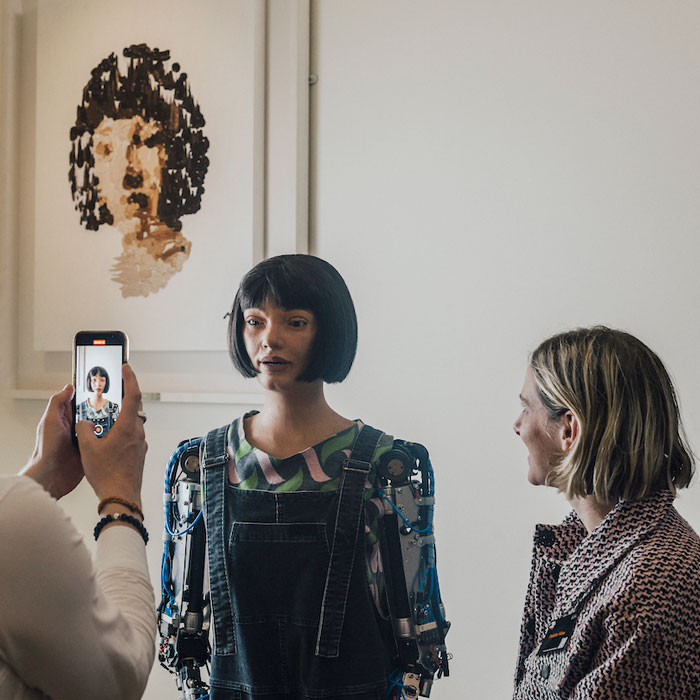
Artist: Ai-Da Robot, Oxfordians Curator: Lucy Seal Project Director: Aidan Meller
In the exhibition ‘AI Mind Home’, Ai-Da Robot makes history as the first humanoid robot to use artistic AI algorithms to design everyday items such as mugs, vases, plates and cutlery, not always with resounding success!
Ai-Da’s designs evoke the increasing dematerialisation of our lives, as we move our social interactions into the digital, through social media, gaming, and the Metaverse. Ai-Da’s household items exist in the physical realm but also in the digital, where in the future they could be used in alternative realities in virtual homes. The development and use of AI is in its infancy, but there is no question it will change lives irrevocably.
Automorph Network: Creative Differences
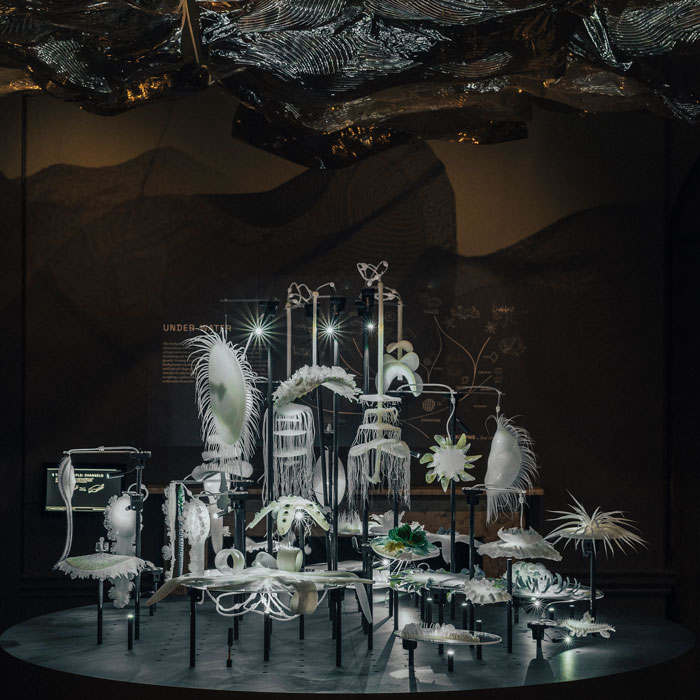
Members: Eran Sharon, Benoit Roman, Lining Yao, Antonio de Simone, Arielle Blonder, Ofri Dar, Dominique Peysson
Creative Differences is a wonderfully engaging installation, a collaboration between scientists and designers, working together on the concept of self-shaping matter. While common human approaches seek to eliminate difference, inhomogeneity is nature’s generative mechanism of variety and harmony. Collaboration via differences, in matter and beyond, paves new paths for ideas and developments that will shape our future.
Matter is not always static; matters can morph. Cells divide, leaves grow, octopuses transform, robots reconfigure, bread rises and pasta swells. Once we start to observe the physical world through a lens with both temporal and spatial dimensions, we see a morphing reality.
Saudi Arabia: Woven
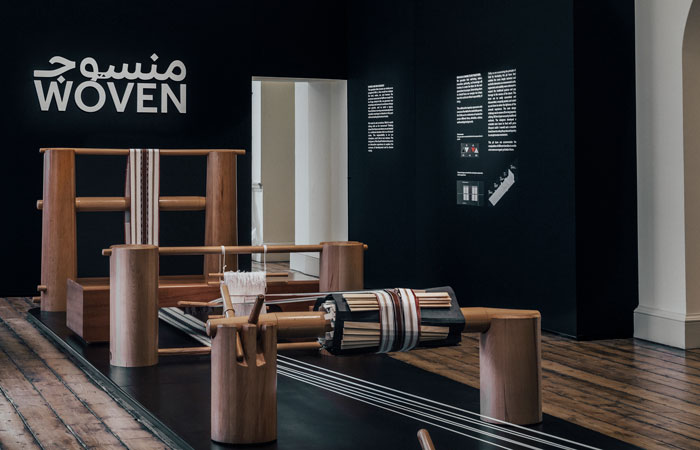
Designers and Curators: Ruba Alkhaldi, Lojain Rafaa
‘Woven’ is a collaborative installation where the future is interwoven with the fabric of humanity. Visitors are invited to participate in the installation, weaving their own section of textile. Originating in the delicate hands of powerful women in the Arabian desert practising the artisanship of Al Sadu – the ‘Saddayah’ weaves humble materials into textiles.
Al Sadu has gained a cultural and social importance that has extended beyond the world of textile weaving to inspire the activities of many different fields. Considered a female-driven art movement, the practice of Al Sadu is part of a material culture and vernacular architecture with the core intention of providing shelter.




